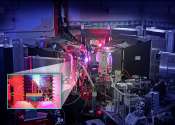Sabotage tool takes on AI image scrapers
Artists who have stood by helplessly as their online works remained ripe for the picking without authorization by AI web scraping operations can finally fight back.
Security

Artists who have stood by helplessly as their online works remained ripe for the picking without authorization by AI web scraping operations can finally fight back.
Engineering

Researchers at the Korea Institute of Civil Engineering and Building Technology have developed building scan to BIM (Building Information Modeling)-based reverse engineering technology required for 3D geospatial information ...
Oct 23, 2023
0
2
Engineering

Every day, there are more than 45,000 flights carrying 2.9 million airline passengers in the United States alone. While supporting this endeavor, aircraft are subjected to a variety of operational conditions from environmental ...
Oct 18, 2023
1
61
Engineering

Using neutrons to see the additive manufacturing process at the atomic level, scientists have shown that they can measure strain in a material as it evolves and track how atoms move in response to stress.
Oct 16, 2023
0
178
Machine learning & AI

Researchers at the Department of Energy's SLAC National Accelerator Laboratory have demonstrated a new approach to peer deeper into the complex behavior of materials. The team harnessed the power of machine learning to interpret ...
Oct 12, 2023
1
55
Hardware

To take an image that is completely in focus, one of the most familiar parts of a camera—the lens—isn't necessary anymore. Instead, a thin mask over the image sensor can do the job. But the kind of mask you use makes ...
Oct 10, 2023
0
28
Computer Sciences

Edge detection is the process of outlining objects in a scene by identifying areas where changes in color or intensity signal boundaries between objects. It is vital in computer vision applications like object recognition, ...
Oct 10, 2023
0
51
Engineering

Rolling bearings are installed wherever something is in rotation. The wide range of applications extends from large wind turbines to small electric toothbrushes. These bearings, which consist of steel components, must be ...
Oct 4, 2023
0
8
Computer Sciences

In contemporary deep learning-based methods for segmenting microscopic images, there's a heavy reliance on extensive training data that requires detailed annotations. This process is both expensive and labor-intensive. An ...
Oct 3, 2023
0
11
Engineering

Material used in organic solar cells can also be used as light sensors in electronics. This has been shown by researchers at Linköping University, Sweden, who have developed a type of sensor able to detect circularly polarized ...
Sep 28, 2023
0
15
An image (from Latin imago) is an artifact, or has to do with a two-dimensional (a picture), that has a similar appearance to some subject—usually a physical object or a person.
Images may be two-dimensional, such as a photograph, screen display, and as well as a three-dimensional, such as a statue. They may be captured by optical devices—such as cameras, mirrors, lenses, telescopes, microscopes, etc. and natural objects and phenomena, such as the human eye or water surfaces.
The word image is also used in the broader sense of any two-dimensional figure such as a map, a graph, a pie chart, or an abstract painting. In this wider sense, images can also be rendered manually, such as by drawing, painting, carving, rendered automatically by printing or computer graphics technology, or developed by a combination of methods, especially in a pseudo-photograph.
A volatile image is one that exists only for a short period of time. This may be a reflection of an object by a mirror, a projection of a camera obscura, or a scene displayed on a cathode ray tube. A fixed image, also called a hard copy, is one that has been recorded on a material object, such as paper or textile by photography or digital processes.
A mental image exists in an individual's mind: something one remembers or imagines. The subject of an image need not be real; it may be an abstract concept, such as a graph, function, or "imaginary" entity. For example, Sigmund Freud claimed to have dreamt purely in aural-images of dialogues. The development of synthetic acoustic technologies and the creation of sound art have led to a consideration of the possibilities of a sound-image made up of irreducible phonic substance beyond linguistic or musicological analysis.
This text uses material from Wikipedia, licensed under CC BY-SA